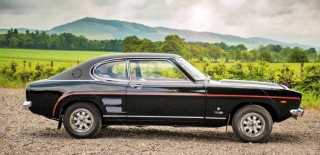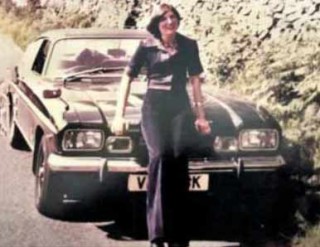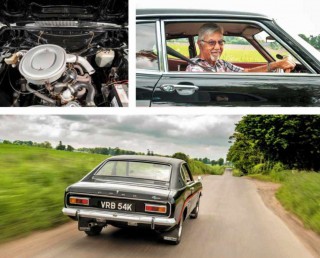Thrashed, banned and saved Capri. Owners past and present reveal this Capri’s tumultuous lifestyle. Life Cycle This rare Ford Capri MkI Special led a wild and colourful life from day one. Owners past and present reveal its ups and downs.
1972 – The new £1300 Capri is used by Horace Mortin
Mortin’s Garage in Buxton, Derbyshire was a Ford agent back in the early Seventies. Horace Mortin was a director of the chain of garages that bore his family name and he was, by all accounts, a memorable character. Mick Keeling was an apprentice at Mortin’s and remembers the boss very well, ‘He loved cars – before the Capri he had a Cortina MkI with a Westinghouse automatic gearbox. He liked going fast; he used to do grass-track racing, though he must have been getting on for 70 by the time he started using that Capri. One day, I turned up on a Honda 400 Four and Mr Mortin asked to try it out. He started it up and roared of round the roads, no helmet or anything.’

Mortin’s Capri, VRB 54K, was one of around 750 Specials made in Ebony Black with a red coachline; another 750 wore Emerald Green with a gold coachline. The Special package was only available on the Capri GT and this was an even more heavily-optioned 1600 GT XLR. Ford was using up remaining body stocks ahead of the September 1972 launch of the Capri’s facelift. Adding a mixture of features from the 3.0-litre and elsewhere in the options book set the Special apart. Keeling remembers being reluctant when required to drive the Capri – ‘It was the boss’s pride and joy,’ he says – but it must have been used fairly hard because one apprentice had to it a new clutch after a few months. But the Capri then moved to a Rootes dealer in Macclesield called Gleeves Motors, probably as a part of a swap within the trade.
1973 – Michael Wain trades up from a Morris 1100
Michael Wain was on the look-out for his next family car. ‘I had children by then and ran a butchers’ shop where I lived in Macclesield,’ he says. ‘I actually saw the car through the window of Gleeves Motors and thought it looked very nice.’
So the first name in the logbook is Mr Wain’s. For a car less than 12 months old, it had a surprising amount of wear in one area. ‘It wasn’t long into my ownership before I had to have a new clutch and clutch cable. The mechanic said it must’ve had a hard life.’

Horace Mortin’s influence on his sale stock was still being felt, then.
‘We went to Anglesey on a family holiday the next year – four seats and a good boot meant there was enough space for a young family,’ says Wain. ‘I looked after it and enjoyed it for its looks. I was impressed with the Capri in general and felt I’d get a good price for it when I traded it in.’
Indeed he did – in the long, hot summer of 1976 Mr Wain traded in the MkI Special against a MkII John Player Special Capri at Burns Garage in Congleton.
1976 – John Phillips pays £1250
For a few sweltering summer days, John and Hazel Phillips had been driving about Cheshire, looking for a new car. Recalls John, ‘I’d had two or three Capris before, but this one jumped out and hit me. It only had 20,000 on the clock. They nearly had to prizeme out of the seat after the test drive.’ The price, £1250, was more than they’d planned to pay, but they cleaned out the Phillips bank account rather than go for hire purchase. It was also very similar to the Capri’s list price in 1972, such was the rate of inflation in Seventies Britain. ‘I brought it back to Macclesield,’ says John. ‘I later realised that I lived in the next street to previous owner Michael Wain.’
The Capri suited the lifestyle of the young couple, who took it on a long-distance adventure around Europe. Recalls John, ‘We went across from Dover to Zeebrugge, then drove down the Rhine and in and out of Switzerland and Austria. We had to turn back when the snow got too deep on the Aalberg Pass. The alternator packed up in Germany and a German Ford garage charged us just £25 to replace it and were done in a couple of hours… they liked the car!’

Phillips made an oval holder for the GB plate and hung it from a bolt on the bumper, ‘I didn’t want to damage the paint!’ This fastidious approach characterised John’s ownership. He’d been a mechanic before moving on to site management for Texaco. ‘The Capri was forever on the ramp in the garage,’ he says. ‘Not that there was much wrong with it, but every minor imperfection got fixed.’
Hazel Phillips with the Capri in the late Seventies.
Even when Capri MkIs were an everyday sight, it seemed a Special – and particularly a black XLR Special – lived up to its name. ‘People used to stop and look,’ says Phillips. ‘These cars had a certain presence. When you saw another one, you’d acknowledge it.’
Nevertheless, time marched on and new additions to the Phillips family forced a change. ‘When our daughter arrived we struggled on with the Capri for a bit but eventually decided on something with four doors – though later I bought a Capri MkIII because I thought the hatchback would make it practical!’
1981– John Smillie persuades Phillips to sell
John Phillips knew a chap called John Smillie from a Macclesield pub, the Rising Sun. Smillie was a merchant seaman and is remembered fondly by Phillips, ‘He was larger than life – a great storyteller and very well read. Being a seaman, he’d disappear for four or five months at a time on long voyages, but he started coming to the garage where I worked and saw the Capri. He’d bring dolls for my daughter from far-of corners of the world and he started telling me that if I ever wanted to sell the Capri, he’d love to buy it.’
Phillips caved in in 1981 and passed the car on to a delighted Smillie, who kept it in a lock-up garage during its many months in between outings, accruing minimal additional mileage over the years. Smillie’s fondness for the Rising Sun eventually landed him in some bother when his licence was suspended for three years after he was caught over the drink-drive limit. By this time he’d owned the car for more than a decade and was reluctant to let it go, so he came up with a highly original solution.
1992 – Stuart Barber becomes temporary keeper
‘I’ve known the car since I was 15,’ says Stuart Barber. ‘That was back in 1975 when I first saw it around Macclesield. Years later, I saw it in the car park of the pub and the registration VRB 54K rang a bell. I went in and asked a local regular whose it was, and he said “mine”. That was John Smillie.’

It was the start of a strong friendship that saw Smillie take Barber under his wing. ‘I’d always liked Capris and I guess John felt he could trust me with his. When he got banned, he had a solicitor draw up a letter saying that while John would retain ownership of the car, registration would be transferred to me.’
Sure enough, Barber ran around in the car for three years, taking Smillie out to the Rising Sun and elsewhere, using it for car shows at weekends. By the mid-Nineties, Capri MkIs had undoubtedly crossed the line from secondhand cars to bonaide classics.
‘I would sell trim and spare parts from Capris I found in scrapyards,’ says Stuart. ‘My son would take the money – he was only six at the time!’
Barber remains a Capri nut, having owned various versions and around 300 scale models. But when Smillie’s ban elapsed, he honoured the agreement and signed the registration back to his friend.
1995 – Allan Jones buys it as a £700 project
As an active member of the Capri Club, Stuart saw an appeal in the club magazine from someone in Cheshire looking for a Capri MkI Special. John Smillie had decided to sell the car shortly after getting his licence back – age was catching up with him and the car needed work so Barber contacted Allan Jones, the man who placed the ad, and passed on Smillie’s number.
‘John was a nice man and quite a character – the deal required a few enjoyable arguments about the price over coffee and cake,’ says Jones, who had his own reasons for wishing to buy Smillie’s car. ‘I’d had a 1600 GT Special back in the Seventies and loved it. I discovered it hadn’t survived, so I wanted one like it.’ Jones finished the coffee-and-cake negotiations in July 1995 and embarked on a fairly rapid and focused restoration, dealing with various scruffy areas and mechanical shortcomings, returning the car to the road in the spring of 1996.
2002 – Tony Sibson pays £1500 in good condition
Allan and Mary Jones moved to Leicestershire in the late Nineties before Allan took early retirement. By then the Capri had been joined by an Escort MkI GT and a Cortina MkIII, and the idea was to sell all three to a classic Ford dealer to help fund a move to Portugal. ‘He wouldn’t offer us enough for the Capri, but he took the other two,’ says Jones. ‘Luckily, Mary had recruited a lady as her replacement at work, and this lady’s husband was keen on the Capri.’
Says Tony Sibson, ‘Once word got to me about the car I bought it straight away. I took it to club meets and local shows through the summer months, but never in the rain!’ However, as the years went by, circumstances changed and the car lost its garage space.
‘I did the servicing myself and sourced an Escort MkI stainless steel exhaust that a garage adapted to it. I replaced a few bits but my skills are more towards the mechanical side than bodywork. Eventually, I took it of the road for a while when money was short and it was laid up outside, under a tarpaulin.’
Some years later, the phone rang and it was Allan Jones – back in the UK and missing the Capri.
2011 – Allan Jones buys it back as a £2200 project
‘I asked Tony if he would sell it back to me and he said no at first,’ says Allan. Tony agrees that he was very fond of the car and planned to get round to fixing it, but eventually relented.
‘I preferred it to go back to Allan than to a stranger,’ he says. ‘I knew it was heading for a good home.’ Allan Jones credits his wife with his re-acquisition. Says Mary, ‘He was worried it was in a rough state, but I told him to buy it back or he’d regret it forever. However when it finally turned up on the trailer and I saw the condition it was in, I burst into tears!’
Outdoor storage and sheer age had taken its toll, so Jones set himself a budget of £6000 for the restoration, with another £2000 for parts.
‘The first quote I got was for £15,000, but then I found a gentleman called Gordon Needs who said “I’ll do as much as I can for £5000-£6000 and then you’ll get the car back.” That seemed a reasonable approach.’ Amazingly, Needs completed the restoration in three months and what came back was a near-finished car. Jones suspects he did very well out of the deal. ‘Gordon said he’d taken a bit of a gamble on the car because you never quite know what you’ll find after a stripdown, but he would honour the commitment. And he did a superb job.’
At the Jones’ home in Perthshire, Scotland, the Capri is the one constant amongst an often-changing fleet of interesting cars. Whether it’s winning prizes at shows or just causing a stampede of excited children when it passes the village primary school, it’s a fixture of family life. And this time, that’s permanent.
‘The deal required a few arguments over coffee and cake’

Thanks to Ford’s stackable options packages, VRB 54K’s full title is Ford Capri 1600 GT XLR Special. Stuart Barber’s six-year-old son selling parts at Ford club events in the early Nineties. At the 1996 Tatton Park Classic Car Show, the Capri’s first car show following its first restoration in 1995. By April 2012, the bodywork was complete and ready to be painted. Today the Capri GT XLR retains its Special-exclusive colour scheme of Ebony Black with a red coachline. Allan Jones and the Capri winning Best in Class trophy at the 2013 Mearns Vintage Vehicle Show. In Gordon Needs’ bodyshop at the start of the second restoration, January 2012. Selected to be Visitors’ Choice display on the Angelwax stand at the 2017 Ignition Festival in Glasgow. Despite hard use early in life, the engine didn’t require major work until the head gasket blew in 2015. Having managed to wrangle a bargain restoration, current owner Allan Jones now enjoys the Capri at every opportunity – albeit at a slightly more sedate pace than its first. Allan Jones bought and restored the Capri twice – but insists he won’t make the mistake of selling it a second time.





